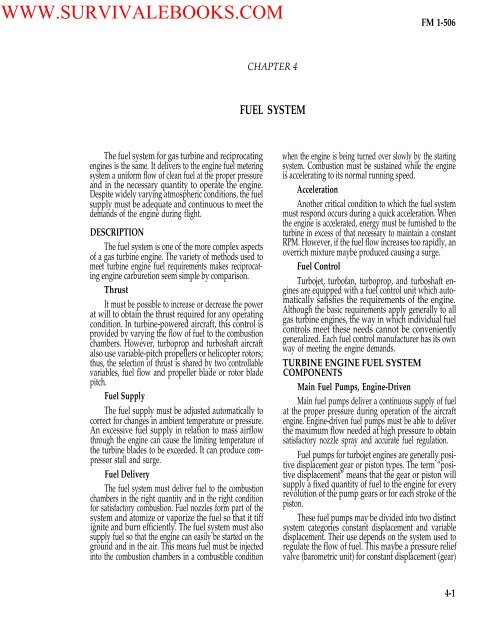FM 1-506 Fundamentals of Aircraft Power Plants ... - Survival Books
FM 1-506 Fundamentals of Aircraft Power Plants ... - Survival Books
FM 1-506 Fundamentals of Aircraft Power Plants ... - Survival Books
You also want an ePaper? Increase the reach of your titles
YUMPU automatically turns print PDFs into web optimized ePapers that Google loves.
WWW.SURVIVALEBOOKS.COM<strong>FM</strong> 1-<strong>506</strong>CHAPTER 4FUEL SYSTEMThe fuel system for gas turbine and reciprocatingengines is the same. It delivers to the engine fuel meteringsystem a uniform flow <strong>of</strong> clean fuel at the proper pressureand in the necessary quantity to operate the engine.Despite widely varying atmospheric conditions, the fuelsupply must be adequate and continuous to meet thedemands <strong>of</strong> the engine during flight.DESCRIPTIONThe fuel system is one <strong>of</strong> the more complex aspects<strong>of</strong> a gas turbine engine. The variety <strong>of</strong> methods used tomeet turbine engine fuel requirements makes reciprocatingengine carburetion seem simple by comparison.ThrustIt must be possible to increase or decrease the powerat will to obtain the thrust required for any operatingcondition. In turbine-powered aircraft, this control isprovided by varying the flow <strong>of</strong> fuel to the combustionchambers. However, turboprop and turboshaft aircraftalso use variable-pitch propellers or helicopter rotors;thus, the selection <strong>of</strong> thrust is shared by two controllablevariables, fuel flow and propeller blade or rotor bladepitch.Fuel SupplyThe fuel supply must be adjusted automatically tocorrect for changes in ambient temperature or pressure.An excessive fuel supply in relation to mass airflowthrough the engine can cause the limiting temperature <strong>of</strong>the turbine blades to be exceeded. It can produce compressorstall and surge.Fuel DeliveryThe fuel system must deliver fuel to the combustionchambers in the right quantity and in the right conditionfor satisfactory combustion. Fuel nozzles form part <strong>of</strong> thesystem and atomize or vaporize the fuel so that it tiffignite and burn efficiently. The fuel system must alsosupply fuel so that the engine can easily be started on theground and in the air. This means fuel must be injectedinto the combustion chambers in a combustible conditionwhen the engine is being turned over slowly by the startingsystem. Combustion must be sustained while the engineis accelerating to its normal running speed.AccelerationAnother critical condition to which the fuel systemmust respond occurs during a quick acceleration. Whenthe engine is accelerated, energy must be furnished to theturbine in excess <strong>of</strong> that necessary to maintain a constantRPM. However, if the fuel flow increases too rapidly, anoverrich mixture maybe produced causing a surge.Fuel ControlTurbojet, turb<strong>of</strong>an, turboprop, and turboshaft enginesare equipped with a fuel control unit which automaticallysatisfies the requirements <strong>of</strong> the engine.Although the basic requirements apply generally to allgas turbine engines, the way in which individual fuelcontrols meet these needs cannot be convenientlygeneralized. Each fuel control manufacturer has its ownway <strong>of</strong> meeting the engine demands.TURBINE ENGINE FUEL SYSTEMCOMPONENTSMain Fuel Pumps, Engine-DrivenMain fuel pumps deliver a continuous supply <strong>of</strong> fuelat the proper pressure during operation <strong>of</strong> the aircraftengine. Engine-driven fuel pumps must be able to deliverthe maximum flow needed at high pressure to obtainsatisfactory nozzle spray and accurate fuel regulation.Fuel pumps for turbojet engines are generally positivedisplacement gear or piston types. The term “positivedisplacement” means that the gear or piston willsupply a fixed quantity <strong>of</strong> fuel to the engine for everyrevolution <strong>of</strong> the pump gears or for each stroke <strong>of</strong> thepiston.These fuel pumps may be divided into two distinctsystem categories constant displacement and variabledisplacement. Their use depends on the system used toregulate the flow <strong>of</strong> fuel. This maybe a pressure reliefvalve (barometric unit) for constant displacement (gear)4-1
















